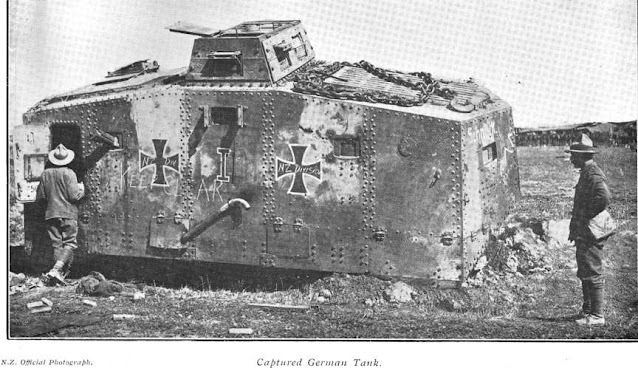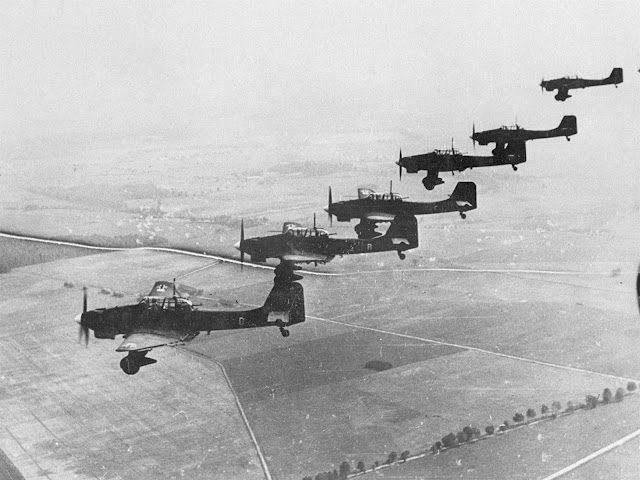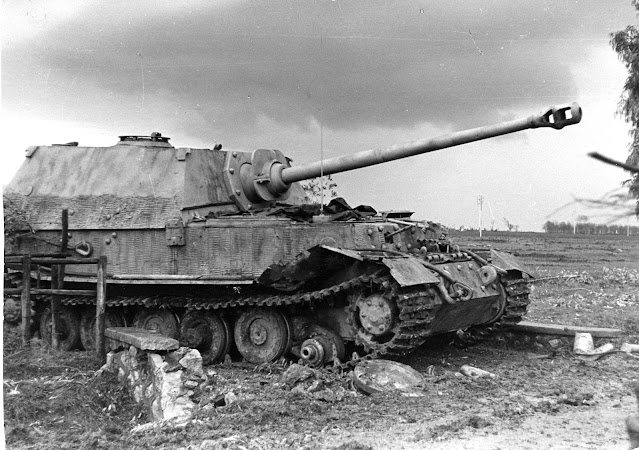Panzers In Service Of A Doomed Effort
 |
| A German Maus II, reassembled in Moscow after World War II, is being examined. It is now on display at the Kubinka tank museum. While a favorite of video game designers, only two or three were built, there is no evidence they were ever used in combat, and the only workable one was blown up by the Germans before it could be captured. I have a page about the Maus with lots of photos here. |
Here we take an overview of
German armored fighting vehicles of World War II. But first, a little history, because history greatly affected the development and use of panzers. This background is necessary to understand how and why German armored vehicles were used.
Tanks as we know them today were first introduced by the British during the Battle of the Somme in September 1916. These were used as "breakthrough" vehicles, paving the way for more vulnerable infantry. They had an immediate impact, being able to cross "no-man's land" between trenches despite the intense defensive fire and even cross over trenches with their long tracks.
The Germans were keenly aware of the effectiveness of tanks but were incapable during the war of producing their own. They only built a very small number of their own, and their most effective armored vehicles became captured British models basically with only new paint jobs.
 |
| "The first official photograph was taken of a Tank going into action, at the Battle of Flers-Courcelette, 15th September 1916. The man shown is wearing a leather tank helmet." The tank is Mark I. Note the "rudder," or steering wheel, at the back. © IWM Q 2488. |
During the interwar period, the German military had a long enforced rest during which its officers had plenty of time to study tanks and develop their own. Generals Heinz Guderian and Erwin Rommel became renowned experts in this new type of warfare and developed tactical doctrines for their use.
 |
| A captured German tank during World War I. New Zealand official photograph. |
To place things in perspective, during the Battle of France in April-June 1940, the composition of the German Panzerwaffe were as follows: 278 Panzer IVs, 349 Panzer IIIs, 955 Panzer IIs, 523 Panzer Is, 106 Panzer 35(t)s, and 228 Panzer 38(t)s. This was an impressive number for the time, though dwarfed by the thousands of tanks on both sides at later battles such as Kurk and the Allied breakout from Normandy.
 |
| Denmark - German Panzer II and Panzer I on parade in front of a tank commander's headquarters at Horsens on Jutland, April 1940 (Stolzenberg, Federal Archive Picture 101I-754-051N-23). |
Except for the Mark IIIs and IVs and perhaps the Czech-built Panzer 38(t)s, Germany’s panzer force wasn't that impressive in these early days. It primarily was composed of light armored fighting vehicles not much better than armored cars. Even the French-built Char BI and Char BI bis tanks were arguably comparable, though they had their own deficiencies such as poor heavy use of petrol. certainly outclassed.
However, it is a mistake to overlook the early WWI German panzers. The Wehrmacht started with no tanks, and it needed a lot. It could be more of the smaller tanks in a quicker period. The smaller tanks even had some minor advantages - they were smaller targets, they used less fuel, and they were easier to train on. But, most importantly, they were available and they worked. If World War II taught anything about weapons, it was that a working weapon that was on the scene was better than some more advanced one that was not.
 |
| A captured French Somua 35, May 1940 (Heinz Boesig, Federal Archive Picture 101I-127-0399-12A). |
The French SOMUA S35 was new, but it was quite a formidable weapon for the time. The German Mark III, arguably the backbone of the Panzerwaffe in 1940, had a smaller-caliber gun than the French tanks, and the Panzer Is and IIs were no match. The British Matilda II tank was slow but otherwise could hold its own with the German panzers. The best advantage the Wehrmacht had was in the sheer number of their armor, with the British in particular having completely inadequate numbers of armored vehicles.
Part of the German doctrine was to use the panzers as the spearhead, or schwerpunkt, against the weakest point of the opponent's line. This "point of concentration" would hopefully produce a breakthrough or rupture of the enemy’s line, to be followed immediately by faster (but lesser armored) moving motorized infantry. To ensure proper coordination, these infantry units (panzergrenadiers) typically formed an intrinsic component piece of the panzer division. The typical panzer division was composed of 2 panzer battalions and 1 motorized infantry battalion with its own self-propelled artillery for support.
That wasn't all. Panzer divisions also carried with them recovery vehicles that could retrieve disabled tanks. These specialized transporters were mobile workshops that could either repair the panzers even on the field of battle or (more likely during the early campaigns) lead them onto a train headed back to Germany.
Since communication was an irreplaceable part of German doctrine, its tanks had to have radios. It took the Allies a surprisingly long tie to appreciate the importance of equipping each panzer with its own radio set. The real advantage of the early German victories lay in this excellent communication between panzers, enabling the overall commander to more effectively direct the division to critical points on the field when they were most needed.
 |
| Luftwaffe Junkers Ju 87 Stukas flying over Poland on a mission, 1939 (Heinrich Hoffman, Federal Archive Picture 183-1987-1210-502). |
This appreciation of the power of communication meant that the Wehrmacht was far better integrated as far as its different services went. The Luftwaffe was designed around a vision of it being an extension of the German Heer (army), able to coordinate its attacks with panzers columns. The panzer divisions would radio circling Junkers Ju-87 Stukas to identify targets blocking the advance on the ground.
Improvisation also became critical to German success during the Battle of France. French General Charles de Gaulle surprised Rommel’s 7th Panzer Division with British Matilda II and French tanks south of Arras. For a time, the German position was desperate, but then Rommel reached into his bag of tricks and unleashed the division’s attached antiaircraft company. It used its small number of 88 mm antiaircraft guns as field artillery by simply lowering the gun barrel parallel with the ground. Astonishingly, this proved devastatingly effective, and thereafter the "88s" became renowned as tank killers. They could destroy enemy tanks with a single shot on the field. This gun became so effective that it was later used as the gun mounted on the Mark VI Tiger and the King Tiger much later in the war. This eliminated the gun's major failing, that it was completely unprotected and a delicious target for Allied gunners when anywhere near the Front.
The development of the Tiger tank reflected this change in circumstances. It was a heavy tank type originally designed for effecting breakthroughs in enemy lines as part of the schwerpunkt. The days of big advances, however, were over, and the Tigers had to adapt to a more defensive role for which they were never designed. In this, they were moderately successful, but their design was overkill for defending static positions. Up-gunned (75 mm) Mark IV models and even mobile artillery such as the StuG series of turretless guns were much more cost-effective, though at times (such as the rescue of trapped German forces at Cherkasy in Ukraine) the Tigers still proved indispensable.
Germany’s WWII Panzer Types & Self-Propelled Tank Killers/Assault Guns
| Panzer I. |
Panzerkampfwagen I
| Panzer II |
Panzerkampfwagen II
Like the Mark I panzer, the Mark II panzer was also technically obsolete by the start of the French campaign. It also was used effectively, however, and played a particularly useful and extensive role as a reconnaissance vehicle. Its chassis was used to make various self-propelled gun vehicles with various levels of success. Main armament: 20 mm cannon. An example of a Mark II is shown below.
| Panzer III |
Panzerkampfwagen III
The Panzer III is one of the most underrated tanks of World War II, with its light completely outshone by later tanks. It originally was designed as Germany’s main battle tank, and it actually was quite effective in this role. It remained significant well into the Russian campaign. The panzer’s chassis was sturdy and reliable and was used for excellent armored variant types, most famously the StuG III. Its main drawback was that it could not accommodate the large guns that became necessary as the war progressed, but it still packed a punch. Main armament: Originally a 37 mm cannon later up-gunned to a 50 mm gun.
| Panzer IV |
Panzerkampfwagen IV
Another pre-war tank, the Panzer IV is the first German tank to achieve legendary status. It originally was envisioned as the Mark III’s companion with a larger 75 mm short barrel firing high explosive anti-personnel ordinance designed to kill off infantry in high concentrations. In February 1941, Hitler insisted against the Heer's objections that Panzer IVs be up-gunned with more effective long barrels for the upcoming Operation Barbarossa. This extremely far-sighted decision became critically important later in the year.
The Panzer IV was the mainstay of the panzer force (panzerwaffe) throughout the war, getting the job done when possible while the flashier Tiger and Panther stole its thunder. Collectors, though, appreciate the Panzer IV and they sell for millions of dollars in good condition. Main armament: Both a short and long barrel 75 mm gun.
| Panther. |
Mark V Panther
This was the first of Germany’s next-generation panzers. It was designed rapidly after the panzers ran into the Soviet T-34 and found it to be a confoundingly effective opponent. In fact, some in Germany just suggested copying the T-34 from the ground up, but German manufacturing processes would not allow that, and neither would German pride.| Tiger tank. |
Panzerkampfwagen VI Tiger
| King Tiger aka Tiger II. |
Panzerkampfwagen Tiger Ausf. B King Tiger
Developed in 1943, this heavy beast (up to 75.5 tons) incorporated all the things learned about armored warfare previously to make a true state-of-the-art tank. More than any other tank, the King Tiger was the culmination of German armored vehicles, incorporating lessons learned from the Tiger I (no interleaved wheels) and the Panther (sloped armor). One of the reasons the Tiger II was so good was that it was not a rushed wartime weapon - design and testing actually began in the late 1930s to fill the hole in the panzer lineup for a heavier tank than the Panzer IV. It usually came in around 69.5 tons, but with fewer design compromises than the Tiger even though it weighed only about 15% more.
This was Germany’s only panzer besides the Panther to incorporate sloped armor. The Soviet T-34 basically introduced sloped armor, and the T-34's success resulted in it gaining an outsized reputation, but sloped armor imposed various tradeoffs (such as space available within the tank) that were not all beneficial. The initial production of 40 King Tigers had an underpowered engine which was upgraded to a more powerful engine (V-12 Maybach HL 230 P30 gasoline - all panzers ran on gasoline, btw) for the remaining production run. Many still felt it was underpowered, but based on all the testing done it was more than sufficient for what it had to do. King Tigers did not have to be fast, they just had to get to where they were going.
This panzer incorporated some of the first electronically assisted gun sights like the Panther tank. The King Tiger really didn’t have long enough service life - only about 489 were built - to iron out the usual teething issues associated with new tanks. It replaced the Tiger I in the production lines and was a worthy successor. Armament: 88 mm (8.8 cm KwK 43). I talk more about the King Tiger here.
 |
| Elefant in Italy April/May 1944 (Robert Vack, Federal Archive Picture 101I-313-1004-25). |
Ferdinand/Elefant Tank Destroyer
When the Wehrmacht finally realized what it was up against in the Soviet Union, it quickly organized a competition to design a heavy tank. The main competitors were Henschel, which had a lot of experience building tanks, and Porsche, which had virtually no such experience. Unsurprisingly, Henschel provided the more efficient vehicle - the Tiger - while Porsche came up with a design that was less like a tank and more like an artillery piece. It also was extremely heavy at about 70 tons, which made it slow and unwieldy. While inferior in the intended role of a breakthrough armored vehicle, the Porsche design still was fearsome and usable. Thus, the Wehrmacht decided on an "all of the above" strategy and ordered about 90 of them.
The Ferdinands, as they were called after the name of the Porsche CEO (and Hitler crony), were rushed into service at Kursk in July 1943 and actually did fairly well. However, they received a bad reputation that was exaggerated by post-war writers due to a lack of secondary armament (machine guns) that Porsche, being inexperienced in this field, did not realize were important. So, stories surfaced of Soviet soldiers creeping up on them and pouring gasoline in their engine vents to set them on fire and so forth.
The main point in their favor, though, was that they mounted Krupp's newly developed 88 mm (3.5 in) Panzerjägerkanone 43/2 (PaK 43). This made them more effective as artillery pieces advancing behind the front rather than, as at Kursk, being used at the tip of the schwerpunkt. Once used properly, they came into their own and acquired a fearsome reputation as a defensive weapon with a probably exaggerated kill ratio better than just about any other Wehrmacht armored vehicle.
While Porsche's lack of experience with tanks was obvious and had baleful consequences, its experience making cars for decades provided some subtle advantages in the engine and suspension areas. The Ferdinands continued providing support fire for retreating Wehrmacht troops, proving much more effective in this role, until being recalled to Germany early in 1944 for modifications (such as the installation of MG-34 machine guns for defensive purposes). They then were sent south to Italy, where they remained in service for as long as they lasted. Because of their distinctive appearance, the troops started calling them "Elefant," and eventually, on 1 May 1944, this became their semi-official name (they actually were the Panzerjäger Tiger (P), but nobody called them that).
The Elefant is the most maligned German armored vehicle, but wrongly so. Despite being prone to mechanical breakdowns as with the Panther - a common situation for World War II tanks on both sides, particularly Soviet ones - the idea that they were ineffective and extremely vulnerable is simply false. While they were all built in early 1943, a company of them lasted until the very end of the war. They saw action on the Oder Front and, finally, defending the Zossen Wehrmacht headquarters (sort of the German Pentagon) south of Berlin in late April 1945. I talk a lot more about the Elefant with photos here.
Sturmgeschütz III (StuG III)
 |
| Sturmtiger. |
Sturmtiger Assault Tiger
 |
| A Hummel in the Soviet Union January/February 1944. Note the open tailgate (Wehmeyer, Federal Archive Picture 101I-278-0898-04). |
Hummel Self-Propelled Gun
Jagdpanther Sd.Kfz. 173
The Jagdpanther was probably Germany’s best tank killer of the war. Unfortunately, this vehicle’s high price limited its overall success with only 415 units produced. Like the StuG series, its design made use of another proven platform, being built on the Panther’s chassis. This also meant that it inherited the Panther's issues, being excessively overengineered and having various mechanical issues. The Panther proved more difficult to convert into an assault gun/tank killer compared with the STUG III/Mark III conversion. However, its sleek design made it quite survivable for its crew. Main Armament: 75 mm gun.